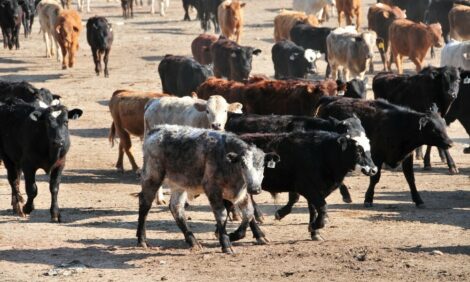



Weekly Outlook: Surprising Corn Estimate
URBANA - For now, expect corn and soybean prices to be well-supported until planting intentions are known, said Darrel Good, a University of Illinois Extension marketing specialist."Significant price volatility, particularly for corn, will be associated with the planting and growing season," said Darrel Good, reacting to USDA reports released on Jan. 12 which were generally supportive for corn and soybean prices.
"The biggest surprise in the reports, however, was the estimated size of the 2006 U.S. corn crop," he noted. "At 10.535 billion bushels, the 2006 crop was 210 million bushels smaller than the September forecast. The U.S. average yield was estimated at 149.1 bushels, 2.1 bushels below the November forecast and 5.6 bushels below the September forecast.
"The January yield estimate was five bushels or more below the November forecast in Kansas, Minnesota, Nebraska, South Dakota, and Wisconsin. The yield estimates were reduced two bushels in Illinois and Indiana and increased by three bushels in Iowa."
The November-to-January decline in the U.S. yield estimate was the second largest in the past 32 years, exceeded only by the 2.4 bushels reduction for the 1993 crop, he noted. The estimate of corn acreage harvested for grain in 2006 was reduced by 400,000 acres. At 70.648 million, harvested acreage was 4.469 million less than harvested in 2005.
The USDA increased the forecast of U.S. corn exports for the current marketing year by 50 million bushels, to a 17-year high of 2.250 billion bushels. The increase reflected the strong pace of sales and shipments to date. The forecast of feed and residual use was reduced by 75 million bushels, to a three-year low of 5.975.
"The reduction reflected anticipated cuts in feed use as a result of higher corn prices," said Good. "The Dec. 1, 2006 stocks estimate of 8.93 billion bushels was 885 million below the level of stocks a year earlier and implied a year-over-year reduction of about 2 percent in feed and residual use of corn during the first quarter of the 2006-07 marketing year."
Year-ending stocks of corn are projected at an 11-year low of 752 million bushels, representing only 6.4 percent of the projected marketing year consumption of 11.76 billion bushels.
"The marketing year average price received by farmers is projected in a range of $3 to $3.40, 10 cents above the December forecast," Good said. "The average price received from September through December 2006 was likely near $2.70. To average the mid-point of the USDA's projection for the year, the average price received from January through August 2007 will have to be near $3.50."
For soybeans, the January estimate of the size of the 2006 U.S. crop was a record 3.188 billion bushels, but 16 million below the November forecast. The change reflected a 0.3 bushel reduction in the yield estimate and an increase of 97,000 in the estimate of harvested acreage.
"Harvested acreage was a record, 74.602 million, 3.351 million more than in 2005," said Good. "The forecast of 2006-07 marketing year exports of U.S. soybeans was reduced by 25 million bushels. At 1.12 billion, exports are still expected to be record large.
"The smaller forecast reflects a slower-than-expected level of shipments in November and December 2006 and the outlook for a record harvest in South America. The forecast of the Argentine crop was increased by 18.5 million bushels for the second consecutive month. Production in all of South America is forecast at 3.895 billion bushels, 145 million larger than the 2006 harvest."
Stocks of U.S. soybeans at the end of the current marketing year are forecast at a record 575 million bushels, 10 million above the December forecast. The marketing year average price received by producers is forecast in a range of $5.75 to $6.45, bout the same as forecast last month.
The average price received from September through December 2006 was likely near $5.70. To average $6.10 for the year, the average price received from January through August 2007 needs to be near $6.50."
The USDA's Winter Wheat Seedings report revealed a 3.514 million acre (8.7 percent) increase. The bulk of the increase is in Arkansas, Kansas, Oklahoma, South Dakota, and Texas, where combined acreage is up 2.265 million. Seedings are estimated at 970,000 in Illinois (up 40,000), 410,000 in Indiana (down 60,000), and 870,000 in Ohio (down 120,000). It appears that soft red winter acreage is down about 140,000 in the eastern Corn Belt, but up 980,000 in the southeast.
"The sharp reduction in the U.S. stocks of corn occurring this year, along with the rapid expansion in ethanol production, implies that U.S. corn production needs to increase sharply in 2007 in order to prevent prices from going to levels that are even more punitive to livestock producers," said Good.
"Much of that increase will come from soybeans. Soybean prices have been following corn prices higher in an attempt to prevent too large a decline in acreage."
With soybean consumption at the current level of 3.066 billion bushels per year, and with a 2007 average yield near that of the past two years, soybean acreage could decline by 10 million in 2007 without bringing 2007-08 marketing year ending stocks under 250 million bushels.
"In addition, if March 2008 soybean futures are maintained at the current level near $7.70, Brazil will likely make a significant increase in soybean plantings in the coming year," he said.
TheCattleSite News Desk


